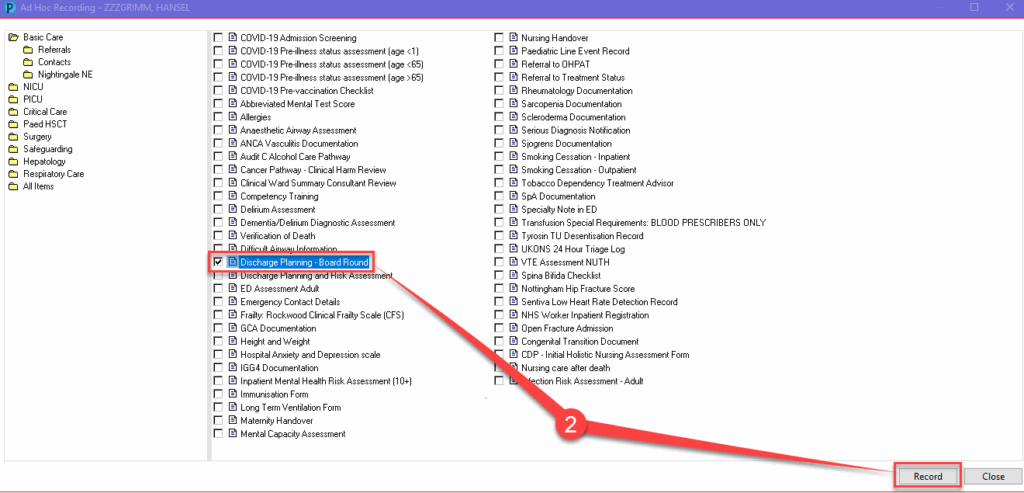Board Round Form
What is it?
- The Discharge Planning – board round form should be updated daily by the MDT team on the ward for all adult inpatients.
- This allows key dates to be captured along with the reason to reside and the discharge pathway that the patient is on.
- There is embedded guidance about discharge pathways in the form
How do I access and open the board round form?
- In the Patient record, click on AdHoc.
- From the opening window, place a tick in the box next to Discharge Planning – Board Round then select Record.

How do I complete the form?
- Expected Date of Discharge should be entered for all inpatients that will stay overnight. This is mandatory in the form.
- Planned Discharge Time can be entered if known to assist with discharge planning on the patient’s final day.
- Discharge Ready Date is the first date that the patient did not meet the Criteria to reside.

The national criteria to reside outlines key indicators as to why a person may need to remain in an acute setting.
- When a patient meets the criteria to reside in hospital, one reason must be selected.

If a person meets none of these criteria but still needs to remain in the acute setting for further assessments/investigations/treatments, OR If a person is still undergoing ward MDT assessments to determine discharge plans, then they meet the criteria under ‘function’, and ‘acute impairment in excess of home/community care provision’.
If a person is MDT fit for discharge and could leave hospital but needs to remain for reasons other than receiving acute care, then they would NOT meet the criteria to reside and would NOT be a clinical exception.
An example of this could be a person who is fit to go home, and equipment is in place (if needed), but there is no capacity within social care to provide a package of care. Or if a person is ready to be transferred to a care home but the care home are
unable to accommodate them that day.This is when a person is classed as being ‘discharge ready’.
We recognise that there will be a cohort of people that have no ‘right to reside’ and are ‘discharge ready’, but it would be unsafe for them to leave hospital until social care is in place. We will use this data to improve future service delivery.
If a patient is awaiting repatriation or rehabilitation in a bedded setting, they meet the criteria to reside as it is unsafe for them to return home, and they must remain in the acute setting until transfer.
- If the patient no longer meets the criteria to reside, the discharge ready date should be entered.
- If there is a clinical exception that means the patient would remain in hospital for another night, this can be recorded in the form.

- The discharge pathway should be entered to allow monitoring and performance data to be collected.
- The Hub Referral question is a prompt only to consider completing the hub referral form.

More information about discharge pathways can be found in the Pathway Guidance section of the form.






